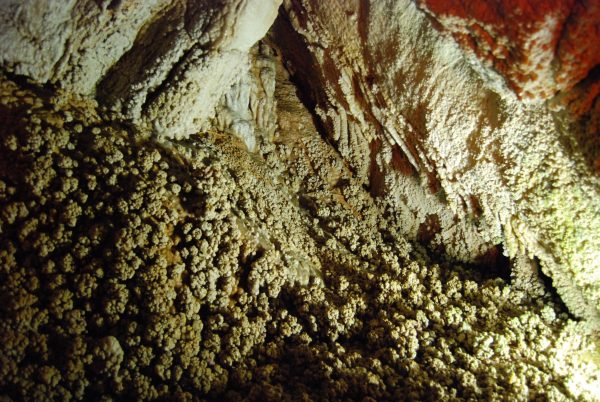The Cave of St. George is the major tourist attraction of the city of Kilkis; it is ranked among the most remarkable caves in Greece and it offers the visitors a unique experience. Especially if it is combined with a visit to the Paleontological Museum, which displays the cave’s findings. It is located at the foot of St. George’s Hill and it was a accidentally discovered around 1925 by quarryman George Pavlidis (Boulasiki), when he opened its entrance during working in the quarry. The recovery operations began in 1977 under her supervision and lasted six years.

The cave also presents a grand paleontological interest. More than 300 samples of fossilized animal bones have been found there in a very good state of conservation (by Vassileios Makridis) aged from 10.000 to 100.000 years old. The age of fossils is determined at 15.000 years. The old environment was a meadow one with shrubs and the paleoclimate rather hot. The hyenas lived in the cave, while the herbivores were either found there by accident or were the main food of the carnivorous animals. Its most important specificity, which is the cause of spreading its fame outside the Greek borders, is that the Cave of St. George is medically indicated as suitable for the treatment of respiratory diseases. Specifically, after a relevant study, the cave of Kilkis has proved to be ideal and accumulated all the conditions as a cave-therapy center, with beneficial effects in cases of chronic respiratory diseases (asthma) and with particularly good results to children, in the treatment skin diseases from allergic infections and overall rejuvenation of the human body. The good conditions of temperature and humidity help in all the cases above, the lack of ozone and dust, low or no existence of microorganisms, the presence of an acidic environment, calcium, magnesium and a number of other physical and chemical factors.

In the 2nd floor of this cafe, one can find the Museum of Paleontology and its permanent exhibition, which is bilingual and has an excellent design and graphic representations which recount the past in a simple and attractive way. The projections include scenes from a model hyena in physical size and a speleologist in action, with the famous cave corals and hundreds of fossils. This experience complements an interactive table on which representations of large carnivores are placed and the visitor has the opportunity to obtain information on the morphological characteristics and touch their bronze skulls which produce sounds.

Transfer Thessaloniki is the best way to discover this beautiful cave! We are here to transfer you from Thessaloniki Airport to St. George cave, in Kilkis. Your transfer, is our pleasure!
